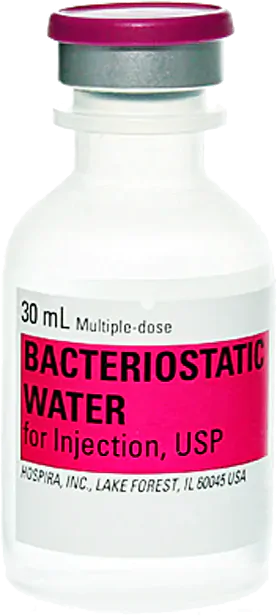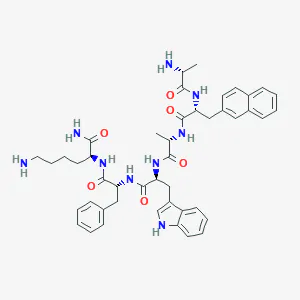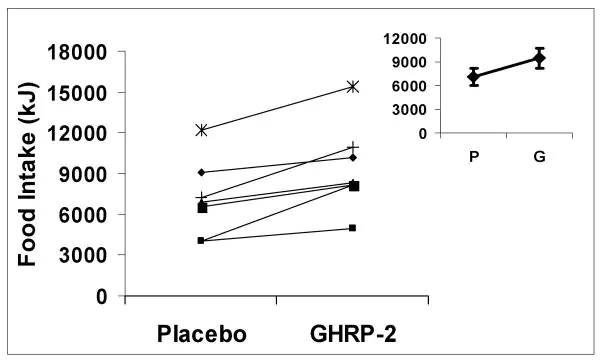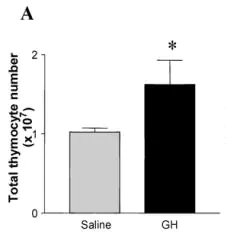



Categorie:Prodotto finito peptide, Peptidi e loro dosaggi

Acqua batteriostatica libera (1) da 30 ml
con ordini qualificati$ 500 USD.
(Esclude prodotti capsule, peptidi cosmetici, codici promozionali e spedizione)
GHRP-2è un secretagogo dell'ormone della crescita sintetico che si lega al recettore del secretagogo dell'ormone della grelina/crescita. È stato dimostrato negli studi di ricerca per migliorare la crescita muscolare, regolare il sistema immunitario e migliorare i cicli del sonno. La ricerca GHRP-2 ha dimostrato che ha una bio-attività orale.
Utilizzo del prodotto:Questo prodotto è inteso solo come chimica di ricerca.Questa designazione consente l'uso di sostanze chimiche di ricerca rigorosamente solo per test in vitro e sperimentazione di laboratorio. Tutte le informazioni sul prodotto disponibili su questo sito Web sono solo a scopo educativo. L'introduzione corporea di qualsiasi tipo nell'uomo o negli animali è severamente vietata dalla legge. Questo prodotto dovrebbe essere gestito solo da professionisti autorizzati e qualificati. Questo prodotto non è un farmaco, un cibo o un cosmetico e potrebbe non essere maltrattato, utilizzato in modo improprio o erroneamente come droga, cibo o cosmetici.
GHRP-2 (a.k.a. pralmorelin) è un secretagogo dell'ormone della crescita sintetico noto per legarsi al recettore del secretagogo dell'ormone della grelina/crescita. È stato il primo dei secretagoghi dell'ormone della crescita da introdurre ed è attualmente commercializzato come peptide di prova per la valutazione della carenza di ormoni della crescita e del fallimento surrenale secondario. GHRP-2 è stato studiato negli studi clinici in stadio II per la valutazione della breve statura ed è sotto ricerca attiva per i suoi effetti su appetito, crescita muscolare, sistema immunitario e cicli del sonno. GHRP-2 è orale e sublingualmente attivo, quindi non deve essere iniettato per avere i suoi effetti.

Fonte:Pubch
Sequenza:D-Ala-D-2nal-Ala-TRP-D-PHE-LYS
Formula molecolare:C45H55N9O6
Peso molecolare:817.9749 g/mol
Pubchem cid: 6918245
Numero CAS:158861-67-7
Nomi di codice:KP-102, GPA-748, Way-GPA-748
La ricerca su YAKS indica che il GHRP-2 può aumentare la crescita muscolare in due modi: aumento della deposizione delle proteine e una riduzione della degradazione delle proteine. La ricerca ha dimostrato che il GHRP-2 può superare gli altipiani di crescita naturale che si verificano negli yak a causa della privazione degli alimenti, delle malattie e delle condizioni ambientali avverse (ad esempio freddo)[1]. The most profound finding from this study is that GHRP-2 reduces muscle atrophy by inactivating atrogin-1 and MuRF1, proteins that control the muscle degradation pathway[2]. There is hope that these findings could be used to reduce the catabolism common in chronic illnesses like autoimmune disease, cancer, and more.
Of course, by activating growth hormone and insulin-like growth factor-1, GHRP-2 helps to boost muscle protein deposition. The combined effect of reducing degradation and enhancing deposition is that GHRP-2 encourages the development of lean body mass even in adverse conditions[3].
GHRP-2 has been shown to boost food intake[4], [5]. Though this may not seem acutely important, appetite stimulation in the setting of chronic disease is an important part of overall health care. The ability to easily and reliably stimulate appetite could help doctors treat chronically ill patients and improve long-term outcomes.

Food intake in healthy adult men, placebo versus GHRP-2
Source: PubMed
Research in fetal heart cell culture lines shows that GHRP-2 and its analogues (GHRP-1 and GHRP-6) can help to protect heart cells by reducing apoptosis or programmed cell death[6]. This is of particular importance following heart attack, when heart cells are particularly prone to apoptosis thanks to decreased blood and thus nutrient supply. Research using an analogue of GHRP-2 called Hexarelin has indicated that there may be a specific receptor for these peptides[7]. Identifying new receptors in any tissue opens pathways for new drug development, but also deepens our understanding of the human physiology and how to prevent dysfunction in the first place.
GHRP-2 has been shown to stimulate the thymus, an organ responsible for protecting certain cells of the immune system. In particular., the thymus helps T cells to mature. T cells are critical for adaptive immunity and our ability to fight off complex infections. Function of the thymus declines with age, which leads to a number of age-related dysfunctions ranging from inadequate tissue repair to lost immunity and thus an inability to fight off infections, guard against cancer, and maintain normal tissue function. GHRP-2 has been shown to rejuvenate the thymus, boosting the number and diversity of T-cells it produces[8]. This leads to improved immunity.

Change in number of active T-cells following administration of GHRP-2
Source: PubMed
GHRP-2 has been shown to increase the duration stages 3 and 4 of the sleep cycles by about 50% each while increasing REM sleep by approximately 20% while reducing the amount that an individual deviates from “normal sleep” by as much as a third. Overall, the improvement in sleep led to improvement in cognitive function, blood pressure, healing, and energy levels[9]. These findings, while useful to all adults, are particularly important in the elderly, where the effects of aging take a toll on sleep quality. GHRP-2 may be useful in understanding how to fine-tune sleep to improve quality and maybe even help people get all the benefits of a full night’s sleep in a fraction of the time.
It was originally thought that observations of decreased pain in animal models of osteoarthritis were the result of GHRP-2 boosting growth hormone levels and accelerating healing in the damaged tissues. Keen scientists observed, however, that the pain relief preceded healing by a substantial margin, suggesting that GHRP-2 may have direct effects on pain perception. As it turns out, GHRP-2 has action at the opioid receptors[10].
There are four known opioid receptors. Most opioid pain medications do not discriminate between them. This is problematic because while some of the receptors mediate pain, others affect things like wakefulness and breathing while still others impact addiction. GHRP-2 is a selective opioid receptor agonist, binding primarily to the receptors responsible for pain relief, sedation, and addiction. This finding indicates that it may be possible to produce selective opioid agonists and therefore mitigate or prevent entirely undesirable effects like respiratory depression and addiction.
GHRP-2 exhibits minimal to moderate side effects, low oral and excellent subcutaneous bioavailability in mice. Per kg dosage in mice does not scale to humans. GHRP-2 for sale at
The above literature was researched, edited and organized by Dr. Logan, M.D. Dr. Logan holds a doctorate degree from Case Western Reserve University School of Medicine and a B.S. in molecular biology.
Jean-Alain Fehrentz was born in Nancy, France, in 1955. He received his Ph.D. degree in Chemistry from the University of Nancy in 1983 and joined the Centre CNRS-INSERM de Pharmacologie Endocrinologie of Montpellier in the research group of Professor B. Castro. From 1989 to 1992 he was appointed as researcher at Sanofi Research in Montpellier. Then he moved to the Faculty of Pharmacy of Montpellier, working under the direction of Professor J. Martinez. His research interests focus onpeptide aldehydes, enzyme inhibitors, peptidomimetics, growth hormone interactions, and heterocycle based receptor ligands. He has published more than 150 scientific papers.
Jean-Alain Fehrentz is being referenced as one of the leading scientists involved in the research and development of GHRP-2. In no way is this doctor/scientist endorsing or advocating the purchase, sale, or use of this product for any reason. There is no affiliation or relationship, implied or otherwise, between
ALL ARTICLES AND PRODUCT INFORMATION PROVIDED ON THIS WEBSITE ARE FOR INFORMATONAL AND EDUCATIONAL PURPOSES ONLY.
The products offered on this website are furnished for in-vitro studies only. In-vitro studies (Latin: in glass) are performed outside of the body. These products are not medicines or drugs and have not been approved by the FDA to prevent, treat or cure any medical condition, ailment or disease. Bodily introduction of any kind into humans or animals is strictly forbidden by law.
PeptideGurus is a leading supplier of American-made research peptides, offering top-quality products at competitive prices. With a focus on excellence and customer service, they ensure a secure and convenient ordering process with global shipping.
CONTACT